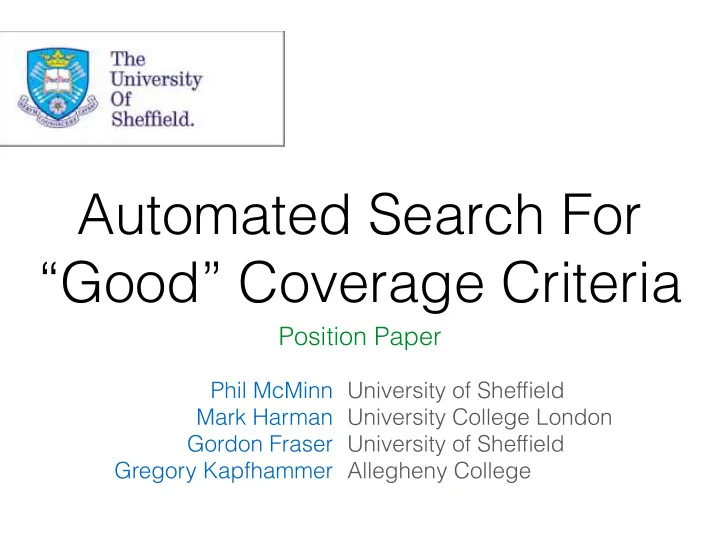

Automated Search For “Good” Coverage Criteria Position Paper Phil McMinn University of Sheffield Mark Harman University College London Gordon Fraser University of Sheffield Gregory Kapfhammer Allegheny College
Coverage Criteria: The “OK”, The Bad and The Ugly The “OK” • Divide up system into things to test • Useful to generate tests on if no functional model exists • Indicates what parts of the system are and aren’t tested
The Bad • Not based on anything to do with faults, not even: • Fault histories • Fault taxonomies • Common faults
The Ugly • Studies disagree as to which criteria are best • Coverage or test suite size?
The Key Question of this Talk Can we evolve “good” coverage criteria? Coverage criteria that are better correlated with fault revelation ?
Why This Might Work • The best criterion might actually be a mix and match of aspects existing criteria • For example “cover the top n longest d-u paths, and then any remaining uncovered branches” • Or…
Maybe this is One Big Empirical Study using SBSE … which aspects of which criteria and how much branches less more less more complex d-u chains less more basis paths
What About Including Aspects Not Incorporated into Existing Criteria Non functional aspects • For example timing behaviour, memory usage • “Cover all branches using as much memory as possible” Fault histories • “Maximize basis path coverage in classes with the longest fault histories”
“Isn’t This Just Mutation Testing?” Our criteria are more like generalised strategies • Potentially more insightful to the nature of faults • Cheaper to apply (coverage is generally easier to obtain than a 100% mutation score) Perhaps different strategies will work best for different types of software, or different teams of software developers
How This Might Work
Fault Database Need examples of real faults • Defects4J • CoREBench • … or, just use mutation
Fitness Function “Goodness” is correlation between greater coverage and greater fault revelation • Needs test suites to establish
Generation of Test Suites At least two possibilities • Generate up front universe of test suites • Generate specific test suites with the aim of achieving specific coverage levels of the criteria under evaluation (drawback: expensive)
Search Representation GP Trees OR AND over 75% basis path coverage up to 50% maximise branch coverage memory usage
Handling Bloat GP techniques classically involve “bloat” • Consequence: generated criteria may not be very succinct • Various techniques could be applied to simplify the criteria, e.g. delta debugging
Overfitting The evolved criteria may not generalise beyond the systems studied and the faults seeded • May not be a disadvantage: • insights into classes of system • faults made by particular developers • … apply traditional techniques from machines learning to combat overfitting.
Summary Our Position: SBSE can be used to automatically evolve coverage criteria that are well correlated with fault revelation Over to the audience: Is it feasible that we could do this?
Recommend
More recommend